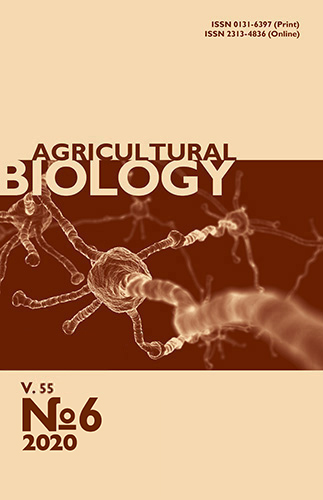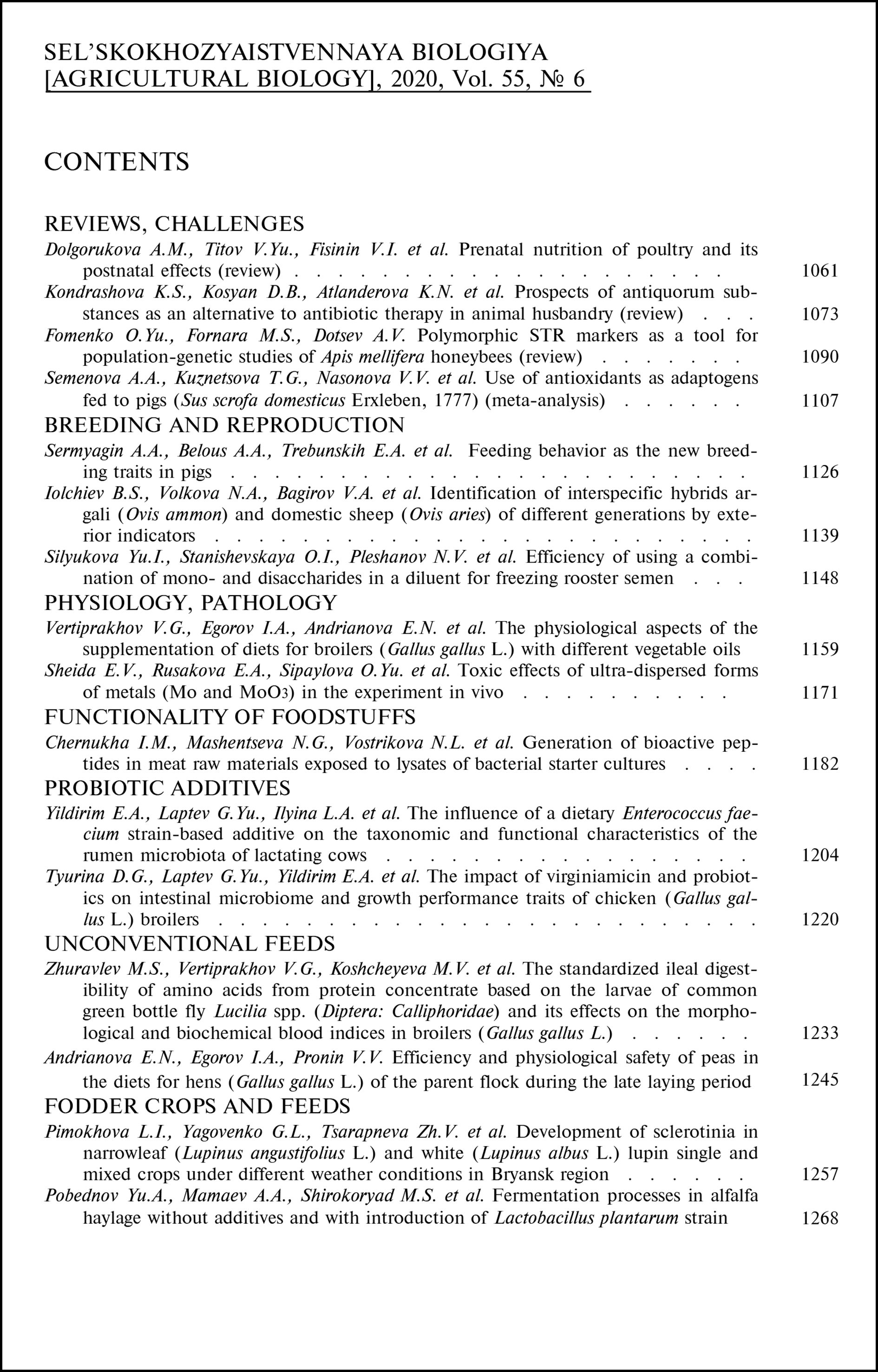doi: 10.15389/agrobiology.2020.6.1171eng
UDC: 615.9:546.77]:57.084.1
Acknowledgements:
Supported financially from the Russian Science Foundation, grant No. 20-16-00078
TOXIC EFFECTS OF ULTRA-DISPERSED FORMS OF METALS (Mo AND MoO3) IN THE EXPERIMENT in vivo
E.V. Sheida1, 2 ✉, E.A. Rusakova1, 2, O.Yu. Sipaylova3, E.A. Sizova1, 2,
S.V. Lebedev1, 2
1Orenburg State University, 13, prosp. Pobedy, Orenburg, 460018 Russia, e-mail elena-shejjda@mail.ru (✉ corresponding author), elenka_rs@mail.ru, sizova.178@yandex.ru, Lsv@list.ru;
2Federal Research Centre of Biological Systems and Agrotechnologies RAS, 29, ul. 9 Yanvarya, Orenburg, 460000;
3Orenburg State Medical University, 6, ul. Sovetskaya, Orenburg, 460000 Russia, e-mail osipaylova@mail.ru
ORCID:
Sheida E.V. orcid.org/0000-0002-2586-613X
Sizova E.A. orcid.org/0000-0002-5125-5981
Rusakova E.A. orcid.org/0000-0002-1622-1284
Lebedev S.V. orcid.org/0000-0001-9485-7010
Sipaylova O.Yu. orcid.org/0000-0003-0243-6249
Received September 24, 2020
Despite the increasing use of nanoparticles (NPs) in industry, there is a serious lack of information regarding their impact on human health and the environment. Thus, nanomaterials based on molybdenum attract attention due to their ultra-high specific surface area and unique optical, electronic, catalytic and mechanical properties. However, having a high penetrating ability, molybdenum can accumulate in excess in organs and tissues of the body, affecting their structural integrity and functional activity. In the present work, the hepatotropic effect of Mo and MoO3 nanoparticles was first established in experimental rats based on an assessment of the degree of activation of the apoptosis marker, a decrease in the level of motor activity and suppression of the emotional state of animals. A decrease in the body weight of rats and liver weight was recorded as a result of a single intraperitoneal injection of NPs while an increase in brain weight occurred. Our goal was to investigate general effects of Mo and MoO3 nanoparticles on the growth and development of the internal organs of rats, the peculiarities of their motor and emotional activities, and the hepatotropic effect of the nanoparticles based on the assessment of the Caspase 3 (Cleaved) expression in the cytoplasm and nuclei of liver cells. Biomedical studies were carried out with 30 white Wistar male rats weighing 110-180 g. Mo and MoO3 NPs were produced by plasma-chemical synthesis. The experimental animals were divided into five groups (n = 6 each). For NPs administration, the rats of groups I and II were intraperitoneally once-injected with Mo at 1.0 and 25.0 mg/kg, respectively, and animals of experimental groups III and IV were once-injected with MoO3 at 1.2 and 29.0 mg/kg, respectively. Animals of the control group were injected with isotonic sodium chloride solution (0.9 % NaCl) in an equivalent volume. The growth of the experimental individuals was monitored daily by individual weighing. At the end of the experiment (day 14), the rats were decapitated under Nembutal anesthesia. Anatomical dissection and weighing of internal organs (liver and brain) were carried out. The absolute and average daily gains were calculated, as well as the weight ratio of the studied organs to the body. To reveal the readiness of liver cells for programmed cell death, expression of caspase 3 (Biocare Medical, LLC, USA) in the cytoplasm and nuclei of hepatocytes was detected immunohistochemically on the stained sections. The open field test was used to assess the emotional, motor activity and behavior of experimental animals. The emotional factor was assessed by the degree of anxiety and fear (the number of fecal boluses), as well as grooming (the number of brushing, washing, and other care elements). A system “Infrared actimeter” with “Panel with holes” (ACT-01, Orchid Scientific & Innovative India Pvt. Ltd., India) was use to assess spontaneous locomotor activity (LMA) of animals. It was shown that Mo and MoO3 NPs have a toxic effect on the normal functioning of some body systems. In particular, the body weight of rats and the weight of their liver decrease while the weight of the brain increases. It was found out that the maximum decrease in body weight occurs in animals that received Mo at a dose of 25.0 mg/kg and MoO3 at 1.2 mg/kg. Mo NPs in both low and high doses provoked a significant decrease in liver weight (by 14.3 and 16.1 %) (p ≤ 0.05), and MoO3 NPs at 1 mg/kg caused a 33.5 % decrease. The injections of Mo NPs at 1.0 mg/kg and 25 mg/kg, and MoO3 NPs at 1.2 mg/kg led to a significant (p ≤ 0.05) increase in brain weigh (by 10.9, 3.85, and 5.49 %, respectively). This increase is possibly due to edema of the organ, which affects behavioral reactions and motor activities in rats, indicating the neurotoxic effect of Mo and MoO3 NPs. Its severity directly depends on time of exposure and particle dosage. There was a decrease in LMA of rats on days 1 and 7 after Moadministration, and the higher the dosage, the lower the activity. The level of locomotor activity decreased to the lowest level on day 14 after administration of 29.0 mg/kg MoO3 NPs. The level of emotional activity was lower for all applied dosages of Mo and MoO3 NPs, and the effect was maximum on days 1 and 7. Evaluation of immunohistochemical expression of activated caspase 3 as a marker of apoptosis in the test with cleaved caspase 3 antibodies revealed an increase in endogenous levels of a larger fragment (p17) of the caspase 3 proenzyme in hepatocytes of male Wistar rats upon administration of Mo and MoO3 NPs. This confirms the hepatotropic properties of the Mo and MoO3 NPs. The detected caspase 3 activation depended not only on the dosage and time after injection of NPs, but also on the lesions caused by the NPs. More severe liver lesions occurred when caspase 3 activation was lower compared to control.
Keywords: nanoparticles, rats, caspase 3, apoptosis, internal organs, brain, behavior, locomotor activity, emotionality.
REFERENCES
- Bonner J.C. Nanoparticles as a potential cause of pleural and interstitial lung disease. Proceedings of the American Thoracic Society, 2010, 7(2): 138-141 CrossRef
- Rossi E.M., Pylkkänen L., Koivisto A.J., Vippola M., Jensen K.A., Miettinen M., Sirola K., Nykäsenoja H., Karisola P., Stjernvall T., Vanhala E., Kiilunen M., Pasanen P., Mäkinen M., Hämeri K., Joutsensaari J., Tuomi T., Jokiniemi J., Wolff H., Savolainen K., Matikainen S., Alenius H. Airway exposure to silica coated TiO2 nanoparticles induces pulmonary neutrophilia in mice. Toxicological Sciences, 2010, 113(2): 422-433 CrossRef
- Sperling R.A., Parak W.J. Surface modification, functionalization and bioconjugation of colloidal inorganic nanoparticles. Philosophical Transactions of the Royal Society A: Mathematical, Physical and Engineering Sciences,2010, 368(1915): 1333-1383 CrossRef
- Asadi F., Mohseni M., Noshahr K.D., Soleymani F.H., Jalilvand A., Heidari A. Effect of molybdenum nanoparticles on blood cells, liver enzymes, and sexual hormones in male rats. Biological Trace Element Research, 2017, 175(1): 50-56 CrossRef
- Ema M., Kobayashi N., Naya M., Hanai S., Nakanishi J. Reproductive and developmental toxicity studies of manufactured nanomaterials. Reproductive Toxicology, 2010, 30(3): 343-352 CrossRef
- Hussain S.M., Hess K.L., Gearhart J.M., Geiss K.T., Schlager J.J. In vitro toxicity of nanoparticles in BRL 3A rat liver cells. Toxicology in Vitro,2005, 19(7): 975-983 CrossRef
- Umezawa M., Onoda A., Takeda K. Developmental toxicity of nanoparticles on the brain. Yakugaku zasshi: Journal of the Pharmaceutical Society of Japan, 2017, 137(1): 73-78 CrossRef
- Mahler H.R., Mackler B., Green D.E., Bock R.M. Studies on metaloflavo proteins III. Aldehyde oxidase, a molybdoflavoprotein. Journal of Biological Chemistry, 1954, 210(1): 465-480.
- Cohen H.J., Fridovich I., Rajagopalan K.V. Hepatic suiphite oxidase, a functional role for molybdenum. The Journal of Biological Chemistry, 1971, 246(2): 374-382.
- Underwood E.J. Trace elements in human and animal nutrition. 3rd ed. Academic Press, New York,1971.
- Seelig M.S. Review: Relationships of copper and molybdenum to iron metabolism. The American Journal of Clinical Nutrition, 1972, 25(10): 1022-1037 CrossRef
- Eremin A., Gurentsov E., Kolotushkin R., Musikhin S. Room-temperature synthesis and characterization of carbon-encapsulated molybdenum nanoparticles. Materials Research Bulletin,2018, 103: 186-196 CrossRef
- Gu S., Qin M., Zhang H., Ma J., Qu, X. Preparation of Mo nanopowders through hydrogen reduction of a combustion synthesized foam-like MoO2 precursor. International Journal of Refractory Metals & Hard Materials,2018, 76: 90-98 CrossRef
- Ayi A.A., Anyama C.A., Khare V. On the synthesis of molybdenum nanoparticles under reducing conditions in ionic liquids. Journal of Materials,2015, 1: 1-7 CrossRef
- Huber J.T., Price N.O., Engel R.W. Response of lactating dairy cows to high levels of dietary molybdenum. Journal of Animal Science, 1971, 32(2): 364-367 CrossRef
- Blood D.C., Radostits O.M. Veterinary Medicine. 9th ed. ELBS, Bailliere and Tindall, London, 2000.
- Yamane Y., Fukuchi M., Li C.K., Koizumi T. Protective effect of sodium molybdate against the acute toxicity of cadmium chloride. Toxicology, 1990, 60(3): 235-243 CrossRef
- Godt J., Scheidig F., Grosse-Siestrup C., Esche V., Brandenburg P., Reich A., Groneberg D.A. The toxicity of cadmium and resulting hazards for human health. Journal of Occupational Medicine and Toxicology, 2006, 1: 22 CrossRef
- Healy J., Tipton K. Ceruloplasmin and what it might do. Journal of Neural Transmission, 2007, 114: 777-781 CrossRef
- Byulleten' normativnykh normativnykh i metodicheskikh dokumentov Gossanepidnadzora, 2009, 4(38): 117-143 (in Russ.).
- Duffin R., Tran L., Brown D., Stone V., Donaldson K. Proinfammogenic effects of low-toxicity and metal nanoparticles in vivo and in vitro: higlhlighting, the role of particle surface area and surface reactivity. Inhalation Toxicology, 2007, 19(10): 849-856 CrossRef
- Alenzi F.Q., Lotfy M., Wyse R. Swords of cell death: caspase activation and regulation. Asian Pacific Journal of Cancer Prevention, 2010, 11(2): 271-280.
- Liu P.-F., Hu Y.-C., Kang B.-H., Tseng Y.-K., Wu P.-C., Liang C.-C., Hou Y.-Y., Fu T.-Y., Liou H.-H., Hsieh I.-C., Ger L.P., Shu C.-W. Expression levels of cleaved caspase-3 and caspase-3 in tumorigenesis and prognosis of oral tongue squamous cell carcinoma. PLoS ONE, 2017, 12(7): e0180620 CrossRef
- Sheida E.V., Rusakova E.A., Sizova E.A., Sipailova O.Yu., Kosyan D.B. Izvestiya Orenburgskogo gosudarstvennogo agrarnogo universiteta, 2019, 1(75): 140-143 (in Russ.).
- Sherkhov Z.Kh., Sherkhov Kh.K., Sherkhova L.K. Izvestiya Kabardino-Balkarskogo nauchnogo tsentra RAN, 2010, 5-2(37): 57-62 (in Russ.).
- Batley G.E., Kirby J.K., McLaughlin M.J. Fate and risks of nanomaterials in aquatic and terrestrial environments. Accounts of Chemical Research, 2013, 46(3): 854-862 CrossRef
- Shaw B.J., Handy R.D. Physiological effects of nanoparticles on fish: a comparison of nanometals versus metal ions. Environment International, 2011, 37(6): 1083-1097 CrossRef
- Dmitrieva E.V., Moskaleva E.YU., Kogan E.A., Bueverov A.O., Belushkina N.P., Ivashkin V.T., Severin E.S., Pal'tsev M.A. Arkhiv patologii, 2003, 65(6): 13-17 (in Russ.).
- Amara S., Khemissi W., Mrad I., Rihane N., Ben Slama I., El Mir L., Jeljeli M., Ben Rhouma K., Abdelmelek H., Sakly M. Effect of TiO2 nanoparticles on emotional behavior and biochemical parameters in adult Wistar rats. General Physiology and Biophysics, 2013, 32(2): 229-234 CrossRef
- Sheida E., Sipailova O., Miroshnikov S., Sizova E., Lebedev S., Rusakova E., Notova S. The effect of iron nanoparticles on performance of cognitive tasks in rats. Environmental Science and Pollution Research, 2017, 24(9): 8700-8710 CrossRef
- Sizova E.A., Miroshnikov S.A., Lebedev S.V., Levakhin Yu.I., Babicheva I.A., Kosilov V.I. Somparative tests of various sources of microelements in feeding chicken-broilers. Agricultural Biology [Sel’skokhozyaistvennaya Biologiya], 2018, 53(2): 393-403 CrossRef












